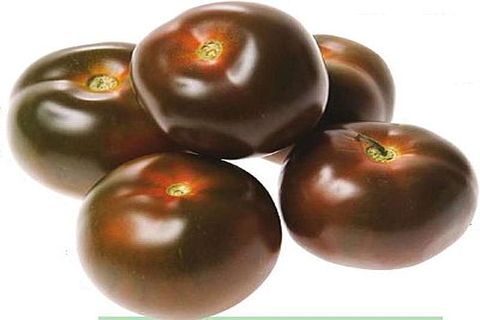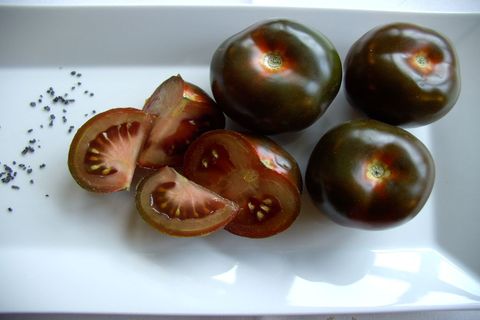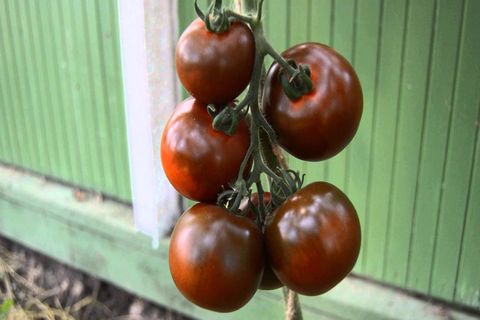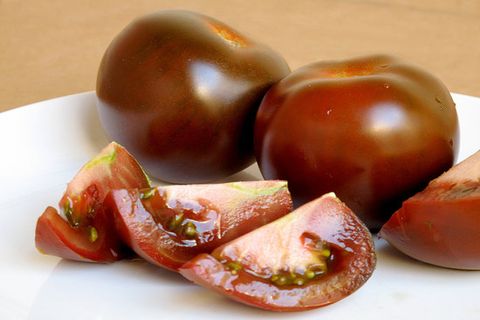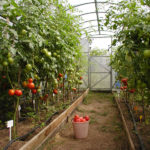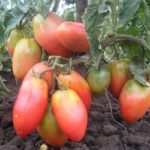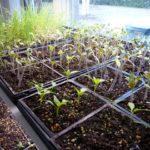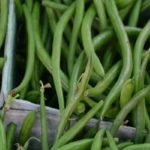Kumato tomatoes have one distinctive feature by which they cannot be confused with any other tomato variety - a black tint. The appearance of this color is due to the presence of certain substances in the composition that are responsible for cellular regeneration and activation of the rejuvenating function, for example, such substances include anthocyanin.
It's interesting that in such black tomatoes Kumato varieties contain an increased amount of vitamins. For example, the level of vitamin C in them exceeds the amount in yellow and red tomatoes by 2 - 3 times.
Main characteristics
Kumato black tomatoes are especially popular among European summer residents and the Turkish population.This popularity is due to the following description of the variety:
- indeterminate bush: many plants grow more than 2 meters in height;
- the stem of tomatoes of the Kumato variety is strong, bristly, and has a liana-like structure;
- characterized by medium foliage;
- More than 8 fruiting clusters are formed on the plant;
- the rhizome of tomatoes of the Kumato variety rapidly grows in different directions by more than 0.5 meters, and the spread occurs without deepening;
- the leaves are characterized by small size and a dark green tint;
- the leaf structure is normal, characteristic of most tomato varieties, with a wrinkled surface;
- the Kumato tomato variety is distinguished by the fact that the first inflorescence is formed above the 9th leaf, and subsequent ones - at intervals of 1 - 2 leaves;
- the description of Kumato tomatoes says that this variety is mid-season - in most cases the ripening period is close to late;
- the first harvest can be obtained 120 days after seedlings;
- one bush gives an average yield of 8 kilograms of fruit, and many summer residents harvest 15 kilograms of tomatoes from 1 square meter;
- the average weight of the fetus is 80 grams;
- the fruits have a round, slightly ribbed shape;
- tomato diameter - 5 - 7 centimeters;
- the thick skin is chocolate-colored, some fruits have green stripes;
- Kumato has a very important characteristic: the variety is resistant to most tomato diseases.
Reviews from summer residents claim that it is best to grow this tomato variety in greenhouse structures. In greenhouses, the Kumato tomato must be shortened. To create a favorable environment for the formation and ripening of fruits, the top of the bush is usually pinched when it reaches a height of 2 meters.
In open ground conditions, cultivation is possible, but in this case the plantings should be insulated.
Advantages and disadvantages
The Kumato tomato variety has a number of advantages. The main one is the composition of the fruit, which is characterized by the content of a huge range of useful substances. Most summer residents highlight the following as advantages:
- good yield;
- tomatoes the size of your choice;
- rapid seed germination;
- fruity sweet taste;
- attractive aroma;
- possibility of long-term transportation;
- resistance to increased temperature, heat;
- disease resistance.
The main drawback is the color of the tomato, which worries people. However, anyone who has planted and tried these tomatoes at least once says: “I’ll plant them next season.” Most gardeners agree on the optimal way to consume the crop: “I grow the Kumato variety of tomatoes for fresh consumption, making soups, salads, and hot dishes.”
Due to their thick skin, such tomatoes are perfectly preserved. Many housewives prepare tomato paste from the harvest or squeeze juice, which has a characteristic fruit and berry flavor.
Interestingly, the taste, beneficial properties and vitamins contained in ripe fruits are not lost under the influence of elevated temperatures.
Growing and care
To get maximum yield, you need to properly grow and care for this variety of tomatoes. Sowing seeds should be organized according to the following instructions:
- It is best to plant seeds of this variety in early March.
- Before sowing, all seeds should be disinfected. To do this, they are immersed in a weak solution of potassium permanganate and then washed with water.
- Planting material is soaked in any growth stimulant.
- The soil is being prepared. The soil must be disinfected and steamed to eliminate the presence of pathogens.
- Before planting, the soil should be warmed to 22 degrees.
- You need to sow the seeds to a depth of 20 millimeters. A distance of 2 centimeters should be maintained between the materials.
- The planted material is watered with settled water and covered with polyethylene. This shelter allows you to create a moist environment favorable for seed germination.
- The pots are moved to a warm, lit place.
- Shoots appear around the 5th day. At this time the coating should be removed.
- After the development of 2 formed leaves, the seedlings are planted in separate containers and fed with mineral fertilizers.
- The plant should be hardened off 14 days before planting. To do this, you should move the container to the balcony or take it out into the fresh air for a couple of hours.
It is necessary to water the seedling material only when the soil dries out. Watering is done on the soil; moisture is not allowed to get on the seedlings themselves.
You can plant seedlings in a greenhouse structure in mid-May, and in open ground conditions - in late May or early June, after the end of frost.
Seedlings should be planted in the soil in holes treated with phosphorus fertilizer, at a distance of 0.5 meters from each other. After planting, the plant is immediately tied to constructed individual support structures. The garter should be made only with synthetic materials.
This tomato variety is easy to care for. To ensure favorable conditions for development, only a few recommendations must be followed:
- Weeding, watering and loosening the soil near the tomato plant should only be done when necessary.
- Black tomatoes respond well to mulching.
- The variety should be fed with mullein and other mineral fertilizers. Feeding is carried out strictly according to the schedule - once every 10 days.
- The lateral and lower shoots of the Kumato variety should be pinched.
Despite the fact that such black tomatoes are resistant to a large number of tomato pathologies, it is recommended to carry out preventive treatment using products aimed at controlling pests and diseases.
With proper care, a formed bush of the Kumato variety will delight the summer resident not only with its health, but also with a rich harvest of tomatoes with excellent taste.

